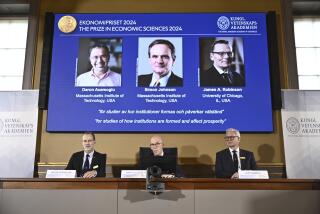Research That Advances ... Well, Nothing
- Share via
The real Nobel prizes hog most of the publicity, but their smart-alecky cousin, the Ig Nobel awards, are way more fun.
This year’s honorees include:
* A study of ostrich courtship behavior toward farmers.
* An analysis of bellybutton lint.
* A computerized device that translates dog barks into human speech.
* A scholarly article on “Scrotal Asymmetry in Man and in Ancient Sculpture.”
The Ig Nobels, now in their 12th year, are sponsored by the Annals of Improbable Research, a science humor magazine that covers scientific achievements that “cannot or should not be reproduced.”
Winning is a dubious distinction.
When Vicki Silvers heard about her prize, “I didn’t know whether to say thank you or that my feelings were hurt.” She eventually decided it “sounded like a lot of fun” and flew to Boston for Thursday night’s ceremony at Harvard University.
Silvers, along with colleague David Kreiner from Central Missouri State University, received the Ig Nobel Literature Prize for discovering that students who buy used college textbooks don’t score as well on tests if the book’s previous owner highlighted the wrong passages. Even if the student tries to ignore the highlighting, it has a detrimental effect, she says.
Hmm. Sounds like a study financed by the college textbook publishing industry. “Not at all,” Silvers says. “I got the idea when I was a junior in college, standing in line behind a guy who was buying a used book. When he saw the highlighting, he said, ‘Oh, cool, dude. I’m just going to read the highlighted parts.’ ”
Other Ig Nobel winners traveled from Japan, Australia, Britain, Germany and Illinois for the award gala, which features real Nobel laureates singing opera and handing out awards while boisterous audience members throw paper airplanes onto the stage.
Researchers from a Japanese toy company picked up the Ig Nobel Peace Prize for inventing Bow-Lingual, a dog-to-human language translation device. The team was recognized for “promoting peace and harmony between the species.” According to news reports, Bow-Lingual uses voiceprint technology to analyze dog barks and translate them into preprogrammed sentences representing six emotions--frustration, happiness, sadness, alarm, desire and self-expression.
The $100 gizmo, which fits on the dog’s collar, debuted in Japan last month and quickly sold out, says Marc Abrahams, the Ig Nobel’s master of ceremonies. An English version is expected by mid-2003.
Four British scientists nabbed the biology prize for their study of “Courtship Behavior of Ostriches Toward Humans Under Farming Conditions in Britain.” Sadly, England isn’t the only nation menaced by lovesick birds. In 1998, a 150-pound emu fixated on an Alabama man, aggressively stalking him whenever he left the house. “He had to carry a gun to take out the trash,” said an animal-rescue official. “He and his family were prisoners in their home.”
Abrahams says the ostrich study, which was honored Thursday by a bumper sticker that read, “North American Man-Bird Love Assn.,” is considered groundbreaking in ostrich industry circles.
The physics prize went to a University of Munich scientist who showed that the Law of Exponential Decay can be used to predict how long beer foam will last.
This year’s most bizarre entry was in the medical category. Chris McManus, a psychology professor from University College London, took top honors for a 1976 journal article analyzing the asymmetrical positioning and size of gonads on antique nude statues in Italian museums.
After reviewing 107 sculptures, he concluded that ancient artists correctly made the right testicle hang higher than the left, but they incorrectly assumed the lower testicle was larger. In reality, research shows that a man’s right testicle is usually larger, he says.
What on earth inspired McManus to conduct such a study? It’s a question that could be asked of many Ig Nobelites. In this case, the answer is a 1764 article on statue crotches that McManus stumbled across in college. Later, while traveling through Italy, he decided to test the accuracy of his predecessor’s theory. “I got out my notebook and started scribbling,” he recalls. The results were eventually published in the journal Nature.
He readily acknowledges it’s a twisted topic. “My original article was only about 380 words,” he says. “But whenever I try to describe it to someone, it takes me about three times that long.”
Today, he remains fascinated by the differences between the left and right sides of the human body and brain. But his research focuses mostly above the belt. His new book, “Right Hand, Left Hand,” discusses right- and left-handedness.
Other 2002 Ig Nobel winners include a pair of scientists from India who devised a formula for estimating the total surface area of elephants, and a Spaniard who invented a washing machine for dogs and cats.
Not every winner decided to attend the ceremony. The Ig Nobel Economics Prize went to the corporate executives and auditors of Enron, Adelphia, Qwest Communications, Tyco and several other corporations for “adapting the mathematical concept of imaginary numbers for use in the business world.”
Which brings us to Karl Kruszelnicki, an Australian physicist and radio host who conducted a comprehensive study on human bellybutton lint. Interviewed by telephone after his arrival in Boston, Kruszelnicki said his project began after a listener on his show asked why bellybutton lint is usually blue.
After combing the scientific literature and finding little information, Kruszelnicki launched his own study, surveying 4,800 people. His conclusion: “You’re more likely to have BBL if you’re male, hairy and have an innie bellybutton.” As to why the lint is usually blue, he explains that most clothing is blue or contains blue dyes.
He also reports that people who switch from a top-loading washing machine to a front-loading model notice a “dramatic drop in the production of BBL.” He theorizes that the gentler washing mechanism in front-loaders makes clothing fibers less likely to come loose and migrate to the bellybutton.
Not content to win one Ig Nobel, Kruszelnicki is already working on his next potential prize. He’s investigating claims that wood hit by lightning is impossible to cut and won’t burn. “We’re collecting wood from trees that have been struck by lightning to solve the riddle,” he says. “Will this benefit the human race? We don’t know.”






